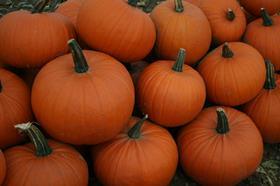
Despite the anticipated annual media scare story that there won’t be enough pumpkins this year, it’s price not production that has pumpkin growers spooked.
Although the market is traditionally stable, one grower believes that next year pumpkins prices will be forced up following the increase of the national living wage. David Bowman, of the eponymous Spalding pumpkin supplier, explains: “The biggest ongoing challenge is wage rates – next year the price of pumpkins will be much higher. The government doesn’t seem to realise what it’s done, it will have a very serious effect indeed.
“By this time next year it will have come home to roost. Wage rates will increase by up to 10 per cent, and when you consider that labour is half our input costs – prices must increase by up to five per cent to cover labour.”
Bowman says pumpkin prices have been the same for years, while retailers are “taking no notice” of what increased labour costs will mean for growers. “Everybody is in the same situation, we are selling pumpkins at the same price we were four years ago, and that can’t go on forever,” he adds.
Mark Thompson, of Kent pumpkin supplier Dan Mackelden, agrees that pumpkin growers will need higher prices but believes other categories will be worse hit. “When the living wage goes up we’ll just have to ask for more for our product,” he says.
“In general pumpkins aren’t too bad – on some products, such as strawberries or raspberries, which operate on very tight margins and need high volumes, even a tiny increase in labour costs makes a massive difference. In general, the pumpkin industry can cope with small increases but we wouldn’t want it to go up too much.
“The whole industry will have to alter, and there will only be one loser – there will be fewer farms and more imports. We will see what effect that has on a year-on-year basis.”
Thompson cites another issue that pumpkin growers are facing as the longstanding battle to get supermarkets to accept product earlier.
“Supermarkets want the product later and later – usually they start selling from 25 October up until 31, and around 80 per cent of the crop is sold between that period, but we can’t pack that amount in that space of time, so we are always badgering them to take product earlier,” says Thompson. “We are also always trying to find ways to pack more volume earlier, by updating packing and cleaning processes, and maintaining an efficient transport system.”
Account manager at Tozer Seeds, Charlotte Wheeler, said the total acreage for pumpkins increased from 1,996 acres in 2014 to 3,004 acres this year in response to growing demand. “The pumpkin market has really exploded. We are seeing massive demand as Halloween is becoming more popular. Do I think edible pumpkins are becoming more popular? Not that I can see. The growth is still in decorative pumpkins,” she adds.
Following what was for many a very difficult 2014, this season is looking much closer to average with crops benefiting from the warm temperatures during the current harvest.
With 3.5 million pumpkins in store and another half a million left to pack, Bowman is cautiously optimistic about the 2015 season.
“It appears to be a better season than last year, which was the worst year I’ve known in 50 years. Halloween falls on a Saturday this year, which is always good, and it’s in half-term week. We have every hope for this season,” he says.
Taking no chances on unpredictable autumn weather, supermarkets have a spread of growers from across the country, according to Thompson, who says that for southern growers this season isn’t looking as good as it could be.
“I think it will be a much more challenging year, although every area is different, as we’ve had unseasonal amounts of rain. I think we’ll have enough volume, and we did very well last year. We are along the south coast so we had a lot less rain than most other areas.”
Thompson’s Maidstone-based company has recorded eight inches of rain across the summer but he says demand increases every year in line with population growth, and believes supermarkets are also offering more pumpkins now.
Logistics and storage innovation will remain key to ensuring a smoother pumpkin season, but varietal development appears to be lower down the agenda. “I’m not using any new varieties, we’ve trialled several this year but there’s nothing I’d stick my neck out for,” says Bowman, while Thompson adds that he’s “not really looking” at varietal development.



